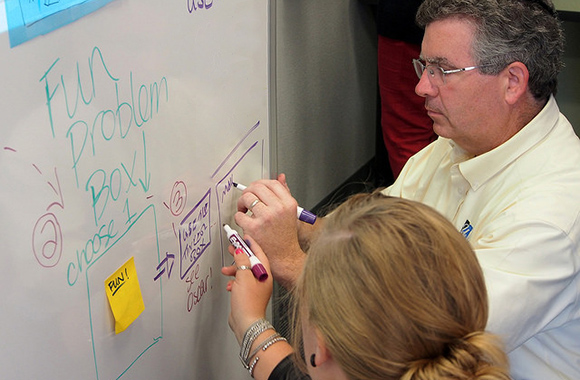
Over the last 20 years, innovation and entrepreneurship (I&E) courses, competitions and other experiential opportunities have gone from unusual to widespread, with over 400,000 students now taking college classes on them each year.
But it isn’t easy to found a new course or program, let alone change an entire campus culture. That’s why we joined forces with Stanford University in 2013 to create the Pathways to Innovation program, with funding support from the National Science Foundation. The Pathways program works with teams of faculty to drive the integration of I&E into undergraduate engineering education. Three years in, 50 US universities representing more than 100,000 undergraduate engineering students are advancing I&E programming and changing their campus ecosystems.
During recent meetings with the latest cohort of Pathways teams, entrepreneurship educators extraordinaire Aileen Huang-Saad from University of Michigan, Liz Kisenwether from Penn State University, and John Ochs from Lehigh University shared what they wished they’d known when they started their entrepreneurship programs and centers. Here’s what they said.
Aileen Huang-Saad (University of Michigan):
- Pace Yourself (it’s more of a marathon than a sprint): Given the myriad things you could do and the lack of time and money to do them, realize that anything you do will have a huge impact. Unlike a startup, where you function on overdrive to get started, in academia there’s no end-game where you can rest. Pick your objectives carefully, focus on specific problems you want to implement, and execute them.
- Choose Wisely (less can be more): Realize you can’t collaborate with everyone. Pick networks that resonate the most, and move forward with them. Count on cultural change to take hold; you can bring more people on later.
- Collect the Data to Demonstrate Your Value (photos and stories are not enough): Collect data from the get-go; you’ll need it to substantiate why your work is important, and you’ll need more than anecdotes. Collect simple data at the beginning (e.g., what programs you ran in year one, how many people attended). Try keep track of where the students are going.
Liz Kisenwether (Penn State):
- Start and Maintain a Student Contact List (it’s easier to build as you go than to reconstruct after the fact): Start creating contact lists for students (non-institutional email addresses, cell phone numbers, etc.) from the very beginning. Use these contacts for longitudinal analysis (e.g., what kinds of jobs are they taking, exit surveys, etc.).
- Feed Stories to the Development/Alumni Offices at Your Institution (give them the material, and they’ll generate interest): Alumni love hearing stories about entrepreneurial students; it gets them excited. Feed stories directly to your development office, write your own press releases, toot your own horn (always include photos and/or video clips).
John Ochs (Lehigh University): To foster student success, integrate the following three elements into the student experience:
- Skillsets (employers want students with 21st century abilities): To be effective, students need to learn how to model, make and measure. They also need to learn soft skills like teamwork, leadership, communication and professionalism, and become globally aware. This will help them contribute to both the technical and business success of the organizations they join.
- Entrepreneurial Mindset (today’s world requires students to think differently): This includes reawakening creative curiosity (the world is constantly changing and students need to be curious and open to learning new things in order to keep up), pursuing collaborative connections, and creating personal, business and societal value throughout the student’s life.
- The Learning Environment (what you’re creating matters): Whether you are creating a makerspace, revisioning the purpose of your library, or working on a flipped classroom, always consider resources, habitat and culture.
These are just a few ideas to consider when starting your own program or center. Watch this video to find out more about how Pathways is catalyzing and sustaining a community of faculty practitioners who are moving I&E forward.
About the authors
 Victoria Matthew leads faculty development initiatives and the Pathways institutional change program at VentureWell. She designs online and in-person programming that fosters the integration and institutionalization of innovation and entrepreneurship, and leverages the power of faculty networks. Prior to VentureWell, Victoria worked for over a decade in higher education. She designed, developed and managed degree programs, and has experience teaching online, and recruiting and training online faculty. Victoria holds a BS from the University of Hull and an MS from Marlboro College.
Victoria Matthew leads faculty development initiatives and the Pathways institutional change program at VentureWell. She designs online and in-person programming that fosters the integration and institutionalization of innovation and entrepreneurship, and leverages the power of faculty networks. Prior to VentureWell, Victoria worked for over a decade in higher education. She designed, developed and managed degree programs, and has experience teaching online, and recruiting and training online faculty. Victoria holds a BS from the University of Hull and an MS from Marlboro College.

Tim Binkert leads storytelling activity at VentureWell, managing the blog, the website and its content, and social media.Tim brings years of experience at VentureWell to bear in relating the stories of faculty and early stage innovators who have moved their ideas to impact through VentureWell’s programs. Tim holds a BA from Syracuse University and a Certificate in Professional Writing and Technical Communication from University of Massachusetts Amherst.
 KD Maynard works part-time with the VentureWell Pathways team, assisting with efforts to infuse innovation and entrepreneurship practices into undergraduate engineering and other STEM programs on college campuses. A longtime higher education administrator, her experience spans a community college through an R1 flagship university, as well as admissions, curriculum and faculty development, dean of student services, and academic dean roles. Living in Vermont affords her the opportunity to hike, paddle, and generally be outside in nature at every available opportunity.
KD Maynard works part-time with the VentureWell Pathways team, assisting with efforts to infuse innovation and entrepreneurship practices into undergraduate engineering and other STEM programs on college campuses. A longtime higher education administrator, her experience spans a community college through an R1 flagship university, as well as admissions, curriculum and faculty development, dean of student services, and academic dean roles. Living in Vermont affords her the opportunity to hike, paddle, and generally be outside in nature at every available opportunity.